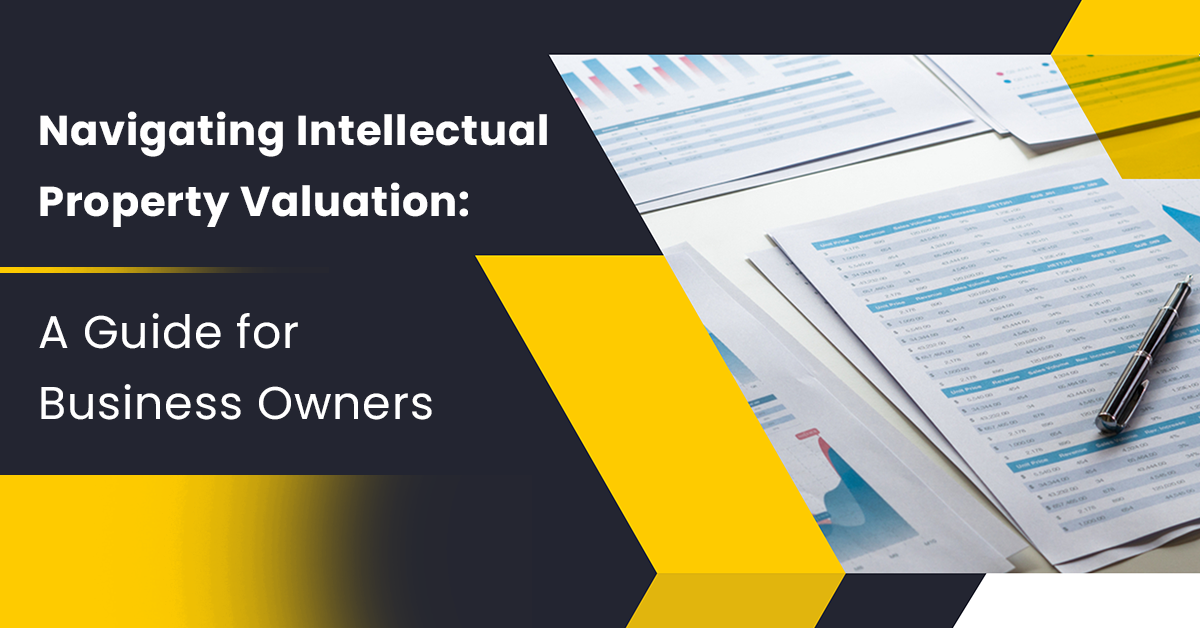Navigating Intellectual Property Valuation: A Guide for Business Owners
February 06, 2023
Admin
Intellectual Property valuation IP valuation Patent valuation Trademark valuation Copyright valuation Technology valuation Licensing valuation Royalty valuation Intellectual property assessment Intellectual property appraisal IP monetization IP due diligence IP asset management Intellectual property
Intellectual property refers to intangible assets such as logos, brand names, patents, trademarks, copyrights, and trade secrets, which are unique identifiers for a company or its products and services. The process of evaluating the economic value of these assets is called Intellectual Property valuation. Accurately valuing an intellectual property is crucial for determining a company's overall worth, as these assets are often its most valuable.
An IP asset must have the following criteria in order to be quantifiable:
The holder or user of intellectual property should receive tangible financial benefits from its possession. This means that the property should have a quantifiable impact on the financial performance of the holder or user. Additionally, the existence of intellectual property should enhance the value of other related assets. This highlights the importance of considering the interplay between intellectual property and other assets when determining its value. Finally, it is important to have a clear understanding of the resources invested, such as time and expenses, in the development of the intellectual property. This information provides crucial context for accurately assessing the value of the property.

Prerequisites of Intellectual Property valuation:
When performing an Intellectual Property valuation, the following variables must be considered:
- Proper identification of the IP asset.
- Clear ownership of the asset.
- Characteristics of the IP, both qualitative and quantitative.
- Ability to generate earnings and profitability through the IP.
- Market share influenced by or resulting from the IP.
- Legal rights, restrictions, competition, entry barriers, and risks associated with the IP.
- The product's life cycle and market position.
- Historical growth and future prospects.
- Investment or expenses incurred in creating the IP.
How to calculate intellectual property valuation?
The value of the intellectual property may be determined using both qualitative and quantitative methods.
Quantitative Methods
- Method 1: The Market-based Method for Intellectual Property valuation seeks to determine the worth of the asset by examining the prices that have been paid for similar assets in the market. The approach uses a quantitative analysis of market data to arrive at a fair value estimate for intellectual property. This method seeks to reflect the market's perception of the value of the asset.
- Method 2: The Cost-based Method for Intellectual Property valuation involves determining the value of an IP asset by calculating the expenses incurred during its creation, including expenses for machinery, labour, legal protection, testing, and overhead costs. There are two cost approaches that can be used in this method: the recreation cost, which refers to the cost of creating identical assets, and the replacement cost, which is the cost of creating assets with the same utility. This method does not take into account the potential risks associated with the future cash flows of the IP. It is based on historical costs rather than projected future costs.
- Method 3: The Income-based Method for Intellectual Property valuation involves estimating the value of an IP asset by forecasting the future revenue it will generate. This method works by determining the present value of expected future cash flows or income generated by the IP. It is considered the most systematic approach to IP valuation and includes the excess profit method and the royalty method. This method relies on projecting future financial performance and calculating the present value of those projections to determine the worth of the IP asset.
Qualitative Methods
- Method 1: Rating and Scoring - This method involves assigning scores based on multiple non-quantifiable parameters, such as strategy, technological standing, brand value, and associated risks.
- Method 2: Value Indicators - This method involves collecting and categorizing data and information about the IPs using statistical tools, which may also be used for internal comparison purposes.
The need for Intellectual property valuation?
To protect the developer from any potential rights violation, it is imperative to first get the IP valued. IP asset valuation helps in the enforcement of rights associated with intellectual property.
Future benefits - An IP asset's worth reflects the prospective financial gains that the IP owner or authorized user might derive from it in the future. The value may be derived by the sale or licensing of the IP to a third party, harnessing the IP by including it in the product, and certain other strategies such as increasing entry barriers or lessening the threat of substitutes.
Resurgent India Limited:
Resurgent India Ltd., a Category 1 Merchant Banker, is one of the leading companies that provide the finest intelligent property valuation services. We have helped numerous firms get accurate intellectual property values with the help of our talent pool of over 200 skilled professionals. Every pertinent facet of a firm is thoroughly analyzed and critically evaluated as part of our intellectual property valuation services. We also provide our services in mergers and acquisitions, private equity, structured finance, capital markets solutions, transaction advisory, government advisory, enterprise risk, stressed asset resolution, fintech solutions and a few other areas.